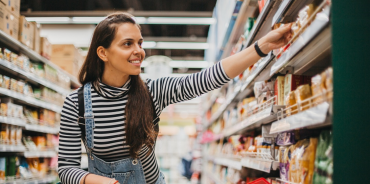As cookies approach their expiry date, retail media promises a better future for brands
It was going to be 2022. Then, the latter part of 2023. Now, in a move that the search giant describes as a “deliberate approach to transitioning”, Google’s long-gestating plan to do away with third-party cookies in its Chrome browser has been delayed to the second half of 2024[1].
While the axe might not be falling just yet, however, there’s little doubt that Google continues to sharpen the blade. The third-party cookie is still crumbling, albeit over a slightly longer timeframe than was originally projected. And when that day does eventually come – whether in 2024 or at some even later date – the digital advertising industry will look very different indeed.
Different how, exactly? That’s not entirely clear. Behind that delayed deprecation is the rather fundamental problem that there’s no solid substitute for third-party cookies; not one that everybody can seem to agree on, at least.
Google’s own replacement plans have met with a varied response. Development on its Federated Learning of Cohorts (FLoC) concept came to an end last year in the wake of criticisms from regulatory bodies and civil liberties groups alike[2], though progress on its overarching Privacy Sandbox programme continues. Elsewhere, cookie-less alternatives seem to be starting to gain traction, contextual ads and Unified ID 2.0 among them[3].
As the ad industry continues to chart its course in a post-cookies world, however, the simple truth for CPG brands and the agencies that represent them is that there’s a ready-made solution to that problem. Better still, it’s one that’s already up and running, and delivering tangible returns that go far beyond impressions or engagement.
Reaching out to relevant audiences
Before we get into the details on that alternative, let’s stay third-party cookies for a moment longer.
While the ethics of third-party cookies are questionable from a privacy standpoint, they’re undoubtedly useful from an advertising perspective, allowing the data that’s gathered as someone browses a website to be used to target them as they move on elsewhere. Essentially, they enable (theoretically) relevant ads to be served to someone as they continue with their online journey.
When that capability goes away, or at least changes in a way that no-one is entirely certain about, that’s going to mean two things. Firstly, it’s going to mean that advertisers need a different way to reach out to relevant audiences. Secondly, and as a result, it’s going to make “publishers” more important than ever.
In this scenario, rather than being media owners in the traditional sense, publishers will be classified as any business that has a substantial, signed-in audience. That’s because when a user is logged in, they’re providing similar – and in many cases much higher quality – information to that offered by third-party cookies. Moreover, that information is being shared entirely consensually by users.
In theory, that means that just about any digital destination with a sufficient userbase can be a publisher. In reality, there’s only one industry outside of social media that attracts signed-in users in the magnitude that advertisers need, and that’s retail. More specifically, it’s online grocery, an area that’s already seen gigantic growth in customer numbers as a result of the pandemic.
Scale isn’t the only issue at play here, however. In addition to the kind of data offered by third-party cookies, first-party data gathered by a grocery retailer can also be overlaid with information from their loyalty programmes – bridging the gap between a customer’s online and offline activity, and presenting advertisers with a more sophisticated and much richer picture of individual preferences.
While those insights would be valuable on their own, their true power becomes apparent when we add the possibilities offered by retail media into the mix.
Targeted, relevant, and measurable
With retailers continuing to build out their media propositions, CPG brands and agencies now have access to a growing number of ways to reach out to grocery shoppers. From basic (yet still highly effective) banner ads through to sponsored search results and additive, personalised recommendations, retail media offers a range of dynamic advertising opportunities.
Powering those media solutions is the first-party data discussed above. In combination with advanced data science that data can be used to create highly specific, objective-based audiences.
Say, for instance, that a brand needs to boost its share within a category. Equipped with the right insights, they could identify and reach out to those shoppers who can best help them meet that goal: lapsed customers, perhaps, or those who currently buy a competing brand but have shown a propensity to churn. Better still, they can communicate in a way that’s appealing to those shoppers, via a promotion or discount offer, for instance.
Compared with the targeting capabilities offered by third-party cookies, that’s a step change in terms of efficiency and effectiveness. Instead of targeting potential customers based on a limited view of past behaviours and trying to nudge them towards a purchase on an unrelated site, brands have the opportunity to build audiences based on rich data and proactively engage them at a time that they’re already looking to buy.
Therein lines one of the other key advantages offered by first-party data. With brands being able to communicate to shoppers within a retail environment, it becomes much easier to track the link between advertising exposure and ultimate impact. Retail media, powered by first-party insights, gives brands the ability to close the loop between sales and marketing data.
Third-party cookies will be with us for some time yet, as will the debate about what will inevitably come to replace them. The good news, for CPG brands at least, is that there’s no reason to wait to find out. A better – more personalised, more relevant, and more measurable – future is already here.
[1] Expanding testing for the Privacy Sandbox for the Web – Google, 27 July 2022
[2] Google’s cookie ban and FLoC, explained – Wired, 25 May 2021
[3] Advertisers' Sweet Tooth Fades, With Many Unfazed by Google’s Latest Cookie Removal Delay – AdWeek, 2 August 2022
TOPICS
RELATED PRODUCTS
Make Retail Media work for your business with Customer Data Science
Retail Media solutionsHelping brands get the most from retail media
Audience Targeting solutionsThe latest insights from our experts around the world



